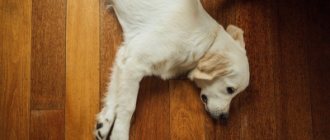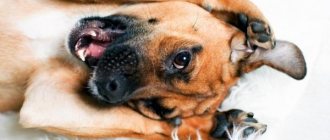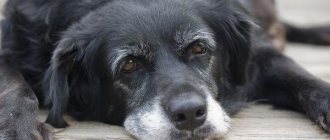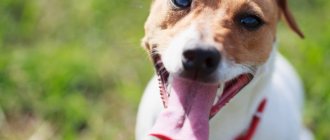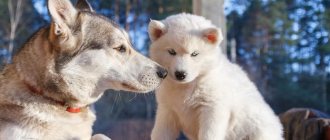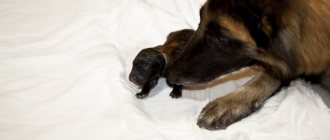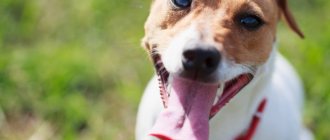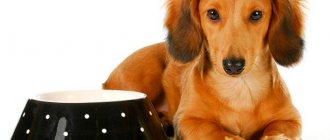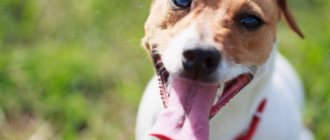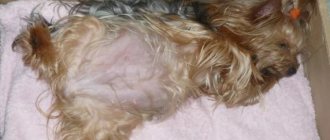Pregnancy in a dog lasts 60-62 days. However, viable offspring can be born at 58 days and up to 72 days. The gestation period varies depending on the breed of the animal. In large dogs and “pocket” dogs it can differ significantly.
Usually dogs give birth easily and humans do not need to interfere with the process. Difficulties can arise during the first birth and in very small dogs. In this case, you need to have the veterinarian’s phone number so that you can contact him if something goes wrong.
The birth of puppies for your pet is a great joy and, at the same time, responsibility. It is important to recognize the onset of labor.
Signs of approaching labor
Whether you plan to deliver the baby yourself or have a veterinarian do it, you should be aware of how the process works.
If you have the opportunity, you can measure the dog’s body temperature one to two weeks before the expected date of labor. To do this, use an electronic thermometer. The temperature is measured by inserting a device into the rectum. The measurement lasts about three minutes. Natural indicators for an adult dog range from 37.5 to 39.2 degrees.
If the temperature drops below 37.5, this indicates that labor will begin within the next 24 hours.
A few days before the puppies are born, the dog’s behavior changes:
- The dog becomes restless. At home, she runs around all rooms and hides behind furniture. Dogs living in an enclosure hide in the kennel, occasionally emerging from it. The animal may whine softly;
- The dog begins to “build a nest” and look for a place for offspring. She can scrape across the floor, drag some things into secluded places;
- Approximately three days before giving birth, the dog’s urine may become cloudy and mucous “scraps” may appear in it, which indicate the beginning of the dissolution of the plug that closes the cervix;
- About a couple of days before giving birth, colostrum may begin to be released when pressing on the nipples . If it is released without physical impact, then labor may begin soon;
- Approximately 5 hours before active labor, a large amount of hormones are released into the pet’s blood. As a result, her pupils dilate. The dog may calm down at this point and become very affectionate. You need to pet the pet, sit and talk to it;
- In most cases, just before giving birth, the dog lies down and does not get up again, licking the genitals, moisturizing them, stimulating the onset of contractions;
- Just before the birth process begins, the dog’s pulse quickens, shortness of breath may appear, and some bitches begin to shiver.
If signs of incipient labor appear, but they have not started within 24 hours, you should take the dog to the veterinarian.
How to arrange a dog bed?
- Where to arrange a place for childbirth? You can place your dog in one place after giving birth and in another place before giving birth. In any case, make arrangements in advance. A place somewhere away from doors and drafts will do. What should the place be like? Dry, spacious, comfortable, soft, warm, durable, open (this will make it easier for you to access the puppies, and the pet will feel better next to its beloved owner).
- Which is best? Large box or playpen. Important: make one of the walls of the dog house slightly lower than the others; the dog should be able to leave its hiding place if desired, but the puppies should not.
- Separate place for childbirth. A large bed or sofa, which needs to be covered with a diaper and a sheet, is suitable. This solution is beneficial for large four-legged friends.
- Heating system. A special lamp or heating pad will help. In the first days of the week, the temperature should not fall below 28 degrees, after which it can be gradually lowered to 20.
Remember: after giving birth, the box where you put the litter should be replaced.
Stages of childbirth
Childbirth in a dog occurs in three stages:
- Preliminary – contractions;
- The main one is the birth of puppies;
- The final one is the separation of the placenta.
The preliminary stage can last from 2 to 24 hours. In addition to contractions (contraction of the uterus), pushing (contraction of the abdominal muscles) is added.
Most often, dogs give birth lying on their right side , but some give birth standing up.
The first stage ends with increased frequency and intensification of uterine contractions.
The second stage begins when the water breaks and the puppies are born. Most often, puppies come out with their heads, but it is possible that they come out with their hind legs first. Both options are considered normal. The interval between the birth of puppies varies from half an hour to three hours.
If more than three hours have passed after the water broke and the puppies have not appeared, the help of a veterinarian is urgently needed. A doctor is also needed if the next puppy does not appear for more than three hours after the birth of the previous one.
The third stage is the release of the placenta surrounding the puppy in the womb. She separates and comes out after the birth of the next puppy. Sometimes the remains of the placenta are expelled in postpartum discharge during the first week after birth.
Most often, dogs eat the placenta. If a dog eats 2-3, then they will be beneficial, because... With them, hormones enter the body that stimulate labor. But more of them will cause stomach upset.
The most typical interval for the appearance of puppies is 15-30 minutes. If the litter is large, 4-6 puppies may appear first, and then there will be a break of one to two hours. And then the rest will begin to appear. With a large number of puppies, labor can last a whole day, and sometimes longer.
The bitch independently frees the puppy from the placenta, gnaws the umbilical cord and then licks it. Usually after this the puppy finds its mother's nipple on its own.
When should you take your dog in labor to the vet?
It is better to initially give birth in a hospital if the male was larger than the female or if the female weighs less than 4 kg and if the pregnancy was difficult.
When to go to the hospital or call the vet:
- The vaginal discharge smells unbearably.
- Long pauses between puppies coming out (more than an hour and a half); before the doctor arrives, massage the dog’s belly with light movements.
- Temperature above 40 degrees (this is a sign of death of the puppy).
- Restlessness of the pet after childbirth, impaired coordination, seizures.
- Loss of consciousness.
- The prenatal period lasts longer than a day.
- The birth of a stillborn puppy.
- The last afterbirth doesn't come out.
You will be much calmer if you invite a veterinarian into your home with the necessary set of medications.
Caring for dogs and puppies after birth
Childbirth is a process that takes a lot of energy from a dog. Therefore, upon completion of the process, the dog needs peace and rest.
You should not show puppies - the bitch may get scared, because... she worries about them. Indeed, in case of danger (if it seems to her), she may try to hide the puppies by causing them some kind of injury.
If your pet begins to give birth, the main thing is not to create panic . The rate of successful births in dogs is close to 100%. But you should know the stages of this process and, if necessary, ask for help from a veterinarian.
Useful tips
- Feed your dog properly during pregnancy (expensive food for pregnant and lactating dogs or natural food with added vitamin supplements).
- Maintain your dog's hygiene during pregnancy and childbirth.
- Dead (?) puppy. The puppy may be born lifeless. Don't give up. Just gently and actively rub it with a clean towel and quickly remove the mucus from the nose and mouth with gauze, massage the chest, and rub it upside down. Gently open his mouth slightly. Do everything to make the puppy squeak.
- If your doe's milk supply is low, start giving her dairy products in large quantities.
- Puppy without a bladder. You need to quickly clear the airways by sucking out the mucus with your mouth.
- The umbilical cord should be cut immediately to prevent the formation of an umbilical hernia in the baby.
- It is necessary to change diapers after each puppy.
- It is important to place the firstborn with the bitch as soon as possible so that he begins to suck milk. This stimulates the birth of the remaining puppies.
- The puppy must defecate, starting the digestion mechanism. If this does not happen, massage his abdomen and anus with a piece of wet cotton wool.
- After each walk, treat the mother's nipples.
And the last piece of advice: never give your dog medications without the presence of a veterinarian to avoid the death of the dog.
Be as sensitive, attentive and collected as possible, and then you will have wonderful, healthy puppies. Your dog will reward you with devotion, love and endless trust.
Top popular breeds in Russia with photos
Nowadays dogs are used both for breeding and as ordinary pets. However, their popularity in no way depends on where people live. It is worth considering the names of dog breeds that are among the ten most popular in Russia.
Yorkshire Terrier
This small animal takes first place in the top ten. This is the only dog that does not cause allergies. Today, Yorkies are the most expensive and decorative dogs. In the past, they hunted animals that lived in burrows, so these dogs are really smart and dexterous.
Labrador Retriever
At the second stage are Labradors. First of all, it is an excellent assistant for its owner, who can save him in any situation. They were originally bred to go fishing or hunting. But over time they moved into the category of friends and companions.
Almost all dogs of this breed are non-aggressive, so they play with small children with great pleasure. In addition, thanks to their excellent sense of smell, Labradors are used to search for drugs or explosives. They can live in an apartment or in a country house.
Husky
The third position is rightfully occupied by Eskimo sled dogs. They are distinguished not only by their kind character, but also by their devotion to their owner. They can get along with children and some pets. Huskies can sometimes be stubborn. They require regular walks or runs.
Jack Russell Terrier
The fourth place is taken by this restless little dog. It was originally bred to hunt burrowing animals. These dogs can be kept in any conditions, but all animals that live in apartments require frequent walking.
Toy Terrier
In fifth place are dogs that were bred to hunt rats. Their sizes are very small, they grow only up to 26 cm. But at the same time, they are quite aggressive.
Pekingese
The sixth place on this list is occupied by small dogs, which used to be a real decoration for palace chambers. At that time, not everyone could buy them, since the cost of pets was extremely high.
German Shepherd
In seventh place are dogs, which are not only house guards, but also rescuers or guides. Shepherds are easy to train because they have a sharp mind.
French Bulldog
The eighth position rightfully belongs to this decorative dog. She is an excellent companion for any person. Dogs are distinguished by their loyalty and also friendliness. By nature, French bulldogs are very affectionate and cheerful. They do not require special conditions of detention.
Shar Pei
The ninth place is occupied by the descendants of the Chow Chow, which were called Shar-Pei. They look quite funny and look a bit like teddy bears. Such dogs have fighting instincts, as well as a fiery temperament.
Chow chow
In last place are dogs that were bred in China. These are wonderful companions; they can accompany their owners even while jogging. Chow Chows are not very fond of small children, but at the same time they can tolerate them.
B
Basenji
These are true companions for humans, as they easily and quickly become attached to their owner and the rest of the family.
Basset Hound
This is a dog with enormous intellectual capabilities, but at the same time loves to be loved and respected. They have a very calm disposition and do not require serious physical exertion.
Bedlington Terrier
It has a unique appearance, but at the same time the dog is distinguished by the presence of pronounced hunting instincts, while possessing a sense of self-esteem.
White Swiss Shepherd
A guard dog breed, therefore, it has all the characteristics inherent in this function. Does not show aggression towards strangers and animals, including dogs.
Belgian Griffon
It is an indoor decorative breed, but is distinguished by its unique development with a change in character. When a dog is young, it is rather weak and inactive. As an adult, she gains weight as well as muscle mass and subsequently becomes active and cheerful.
Belgian Shepherd
The dog is quite smart and has excellent security characteristics. She has a lively and intelligent look. However, it is not recommended for maintenance by inexperienced or indecisive owners.
Bernese Mountain Dog
This dog has many positive characteristics. This is not only a strong and hardy breed, it is very devoted to its owner and has a good-natured disposition.
Biewer Yorkshire Terrier
A decorative dog breed with a balanced temperament, but at the same time with a strong and strong-willed character. Feels great in the home company of people and animals.
Beagle
At one time, the breed of dogs helped people hunt small but nimble animals. The dog is friendly, smart, affectionate and energetic.
Bichon Frize
This is a naturally cheerful and playful dog. In addition, she is brave and non-aggressive, but at the same time she has a complex disposition that requires education and training.
Bloodhound
This is a true hound breed, extremely active, requiring constant physical activity. Otherwise, he will be able to turn the apartment into a trash bin.
Bobtail
Bobtails, despite their (comparatively) intimidating appearance, are distinguished by their friendly nature and loyalty towards family members.
Bolognese
The appearance of this breed is very attractive and interesting. They love their owners, but are distrustful of strangers.
Border Collie
The breed is an extremely energetic and fast-moving animal, and therefore requires constant physical activity.
Dogue de Bordeaux
A fairly ancient French breed, the ancestors of which are Roman fighting dogs. This breed was originally used to protect human settlements from wolves and bears.
You can't tell by its appearance that this dog has a very friendly character.
Beauceron
The breed is distinguished by the fact that it is quite social, since it is distinguished by its friendliness, both to its relatives and to other animals. The intelligence of this dog is at a high level.
Boston Terrier
This is a dog that has absorbed a lot of both positive and negative qualities. Needs qualified education and training.
Brazilian Fila
Can successfully protect an object that a person has entrusted to him. Shows distrust of strangers and even at exhibitions keeps everyone at a distance, including judges.
Brussels Griffon
Despite its small size, the breed knows its worth, but at the same time they show friendly feelings and love to play.
Bullmastiff
The breed is distinguished by boundless devotion to its owner, but at the same time they behave non-aggressively towards family members, acquaintances and friends, and are wary when meeting strangers.
Bull Terrier
A rather capricious and stubborn dog, therefore it requires a qualified approach to training and education. In addition, bull terriers must be constantly monitored, otherwise they will try to independently expand the boundaries of what is permitted.
Boerboel
These are strong and hardy dogs, with a beautifully built body that requires constant physical activity. For them, daily walks of 5 km are the minimum load.
